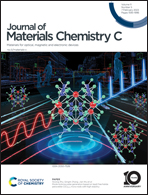All-small-molecule efficient ternary organic solar cells employing a coumarin donor and two fullerene-free acceptors†
Abstract
Organic solar cells (OSCs) prepared from ternary bulk heterojunction active layers offer a simplistic and proficient tactic for enhancing power conversion efficiencies (PCEs). Herein, we report the construction of all-small-molecule ternary OSCs using a medium bandgap IDT-IC and a narrow bandgap F13 as fullerene-free molecular acceptors along with a wide bandgap C1-CN as a molecular donor. The crystalline nature of IDT-IC induces the appropriate nanoscale in the range of the exciton diffusion length in the C1-CN:F13 binary film, resulting in a higher PCE of 15.54% than that for C1-CN:F13 (14.23%) and C1-CN:IDT-IC (6.17%). Although the open circuit voltage (VOC) for the C1-CN:IDT-IC:F13 ternary organic solar cell is lower than that for C1-CN:F13, the improved PCE is mainly due to the increased values of short circuit current and fill factor. The improvement in the fill factor may be attributed to the enhanced charge transport and minimal recombination loss due to the enhanced phase separation in the ternary films. The increase in the short circuit current is attributed to the increased interfacial area for exciton dissociation and the effective utilization of excitons via the energy transfer for IDT-IC to F13.



 Please wait while we load your content...
Please wait while we load your content...